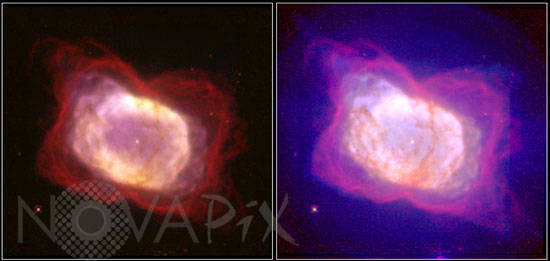Photo Agency - Astronomy - Space - Nature

Planetary nebula NGC 7027 in Cygnus.
author: Nasa/Novapix
reference: a-nep70-27001
Image Size 300 DPI: 23 * 11 cm
The composite color image of NGC 7027 (on the left) is an infrared image taken with NICMOS on the Hubble space telescope. This picture is actually composed of three separate images taken at different wavelengths. The red color represents cool molecular hydrogen gas, the most abundant gas in the universe. The image reveals the central star, which is difficult to see in images taken with visible light. Surrounding it is an elongated region of gas and dust cast off by the star. This gas (appearing as white) has a temperature of several tens of thousands of degrees Fahrenheit. The object has two "cones" of cool molecular hydrogen gas (the red material) glowing in the infrared. The gas has been energized by ultraviolet light from the star - a process known as fluorescence. Most of the material shed by the star remains outside of the bright regions. It is invisible in this image because the layers of material in and near the bright regions are still shielding it from the central star's intense radiation.
On the right, the visible and infrared light picture of NGC 7027 provides a more complete view of how this planetary nebula is being shaped, revealing steps in its evolution. This image is composed of three exposures, one from the Wide Field and Planetary Camera 2 and two from NICMOS. The blue represents the WFPC2 image; the green and red, NICMOS exposures. The white is emission from the hot gas surrounding the central star; the red and pink represent emission from cool molecular hydrogen gas. In effect, the colors represent the three layers in the material ejected by the dying star. Each layer depicts a change in temperature, beginning with a hot, bright central region, continuing with a thin boundary zone where molecular hydrogen gas is glowing and being destroyed, and ending with a cool, blue outer region of molecular gas and dust. NICMOS has allowed astronomers to clearly see the transition layer from hot, glowing atomic gas to cold molecular gas. The origin of the newly seen filamentary structures is not yet understood. The transition region is clearly seen as the pink- and red-colored cool molecular hydrogen gas. NGC 7027 is located about 3,000 light-years from the sun in the direction of the constellation Cygnus.
On the right, the visible and infrared light picture of NGC 7027 provides a more complete view of how this planetary nebula is being shaped, revealing steps in its evolution. This image is composed of three exposures, one from the Wide Field and Planetary Camera 2 and two from NICMOS. The blue represents the WFPC2 image; the green and red, NICMOS exposures. The white is emission from the hot gas surrounding the central star; the red and pink represent emission from cool molecular hydrogen gas. In effect, the colors represent the three layers in the material ejected by the dying star. Each layer depicts a change in temperature, beginning with a hot, bright central region, continuing with a thin boundary zone where molecular hydrogen gas is glowing and being destroyed, and ending with a cool, blue outer region of molecular gas and dust. NICMOS has allowed astronomers to clearly see the transition layer from hot, glowing atomic gas to cold molecular gas. The origin of the newly seen filamentary structures is not yet understood. The transition region is clearly seen as the pink- and red-colored cool molecular hydrogen gas. NGC 7027 is located about 3,000 light-years from the sun in the direction of the constellation Cygnus.
Keywords for this photo:
1998 - ASTRONOMY - CYGNUS - DWARF - DYING STAR - EVOLUTION - HST - HUBBLE SPACE TELESCOPE - INFRARED - NEBULA - NGC 7027 - PLANETARY NEBULA - STAR - WHITE DWARF -
Contact : Stéphane Aubin +33-(0)9-51-26-53-76
© Novapix - All rights reserved


